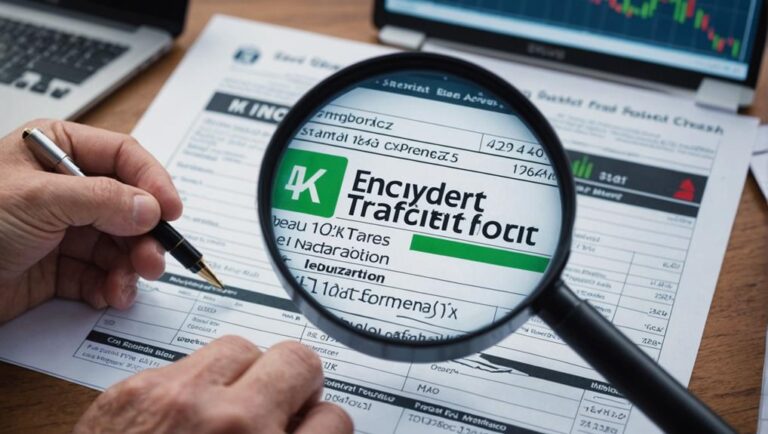Insider Trading and SEC Form 4: A Comprehensive Guide for Investors

Insider trading and SEC Form 4 are essential components for maintaining transparency and trust in the stock market. SEC Form 4, a regulatory requirement under the Securities Exchange Act of 1934, mandates that insiders report their stock transactions within two business days. This disclosure is crucial for investors as it provides insights into insider sentiment and management’s confidence in the company.
Accessible to the public through the SEC’s EDGAR database, SEC Form 4 allows investors to track potential movements in stock prices and identify any potentially illegal trading activities. By understanding important filing dates and transaction codes such as ‘P’ for purchase or ‘S’ for sale, investors can make more informed decisions when it comes to their investments.
In conclusion, staying informed about SEC Form 4 filings can give investors a competitive edge in the market by providing valuable information about insider activities. This knowledge can help investors better understand the dynamics within a company and make informed decisions based on real-time data.
Key Takeaways
SEC Form 4 compels insiders to report stock transactions promptly, maintaining transparency in the market. These filings are accessible through the SEC’s EDGAR database, offering valuable insights into insider trading activities. Transaction codes on Form 4, like ‘P’ for purchase and ‘S’ for sale, classify different types of insider transactions, aiding investors in understanding insider sentiment.
The timely disclosure of Form 4 assists investors in assessing management’s confidence in the company. By monitoring these filings, investors can make more informed decisions based on insider trading patterns. Failure to promptly file Form 4 can lead to fines and penalties for insiders, ensuring accountability and upholding market integrity.
Understanding SEC Form 4
SEC Form 4 is a crucial document that insiders of public companies must submit to reveal their transactions involving company stock, such as purchases and sales. This form is mandated by Section 16(a) of the Securities Exchange Act of 1934 and plays a vital role in ensuring transparent financial reporting. Insiders, including officers, directors, and significant shareholders, are obligated to file Form 4 within two business days when they engage in such transactions. This rapid reporting requirement helps prevent illegal insider trading and enhances market integrity.
The information disclosed in these filings is publicly available through the SEC’s EDGAR database. Analyzing SEC Form 4 enables us to gain valuable insights into insider sentiment, which often mirrors management’s confidence in the company’s future prospects. Notably, substantial stock purchases by insiders may indicate a belief in the company’s growth potential, whereas sales could suggest otherwise.
Understanding these disclosure obligations empowers us to effectively monitor insider transactions, thereby assisting in making informed investment choices.
Keeping abreast of trends in insider trading through SEC Form 4 filings allows us to anticipate stock price fluctuations more accurately and make better-informed decisions in the financial markets. Thus, monitoring SEC Form 4 submissions is a critical strategy for individuals seeking to stay well-informed and proactive in their investment endeavors.
Importance of SEC Form 4
SEC Form 4 is a vital tool for maintaining market integrity and bolstering investor confidence. Mandated by the Securities and Exchange Commission (SEC), this form requires officers, directors, and major shareholders to disclose any purchases, sales, or changes in ownership of company securities. These disclosures, known as insider trading reports, are essential for ensuring compliance with reporting requirements under Section 16 of the Securities Exchange Act of 1934.
Analyzing SEC Forms like Form 4 can provide valuable insights into insider sentiment and potential stock movements. When company insiders buy or sell their own stock, it can indicate their confidence levels or concerns regarding the company’s future performance. This insider sentiment serves as a significant indicator for predicting stock price fluctuations.
The accessibility of these filings through the SEC’s EDGAR system enables investors to identify trends and make well-informed decisions. By utilizing Form 4, investors can’t only spot potential illegal insider trading but also gauge the management’s confidence in the company’s outlook, thereby fostering good governance practices.
Reading SEC Form 4

Let’s dive into the key filing dates first to understand when insiders must report their transactions. Insiders are required to disclose their trades within two business days.
We’ll also cover the different transaction codes used to indicate the type of trade or change in ownership, offering clarity on the transaction’s nature.
Furthermore, we’ll discuss the responsibilities insiders have when reporting these activities to ensure full transparency and compliance with regulations.
Key Filing Dates
Understanding the essential filing dates for submitting SEC Form 4 is crucial for maintaining compliance and ensuring transparency in insider transactions. When an insider conducts a transaction involving their company’s securities, they are required to file SEC Form 4 within two business days. This filing is vital for adhering to SEC regulations and avoiding potential civil actions.
Timely submission of SEC Form 4 is key in upholding transparency, enabling the public to monitor changes in insider ownership. This transparency assists investors in assessing insider sentiment and making well-informed decisions. Failure to meet the filing deadline can lead to severe consequences, such as civil or criminal actions.
Below is a helpful table outlining the key filing dates:
| Event | Filing Deadline |
|---|---|
| Insider transaction occurs | Day 0 (transaction date) |
| First business day | Day 1 |
| Second business day | Day 2 (filing deadline) |
| Late filing consequences | Potential civil or criminal actions |
| Investor impact | Enhanced transparency and compliance |
Ensuring timely submission of SEC Form 4 is essential for maintaining compliance and transparency in insider transactions, benefiting both insiders and investors alike.
Transaction Codes Explained
Understanding transaction codes on SEC Form 4 is crucial for analyzing insider trades. These codes categorize different types of transactions, such as purchases, sales, or gifts. By decoding these codes, investors can gain valuable insights into the actions of company insiders and make more informed decisions.
Each transaction code on Form 4 serves a specific purpose. For example, the code ‘P’ indicates a purchase, showing that an insider is acquiring shares, possibly signaling confidence in the company’s future prospects. On the other hand, code ‘S’ represents a sale, suggesting that the insider is divesting, although this doesn’t always imply negative sentiment. Gifts are denoted by code ‘G’, often indicating strategic transfers without monetary consideration.
Analyzing these transaction codes can provide valuable information about insider behavior and sentiment. By paying attention to these codes and their implications, investors can better understand the dynamics of insider trading and incorporate this knowledge into their investment strategies.
Insider Reporting Obligations
Studying SEC Form 4 offers a valuable glimpse into the intricate transactions of company insiders, shedding light on their trading activities. These reports provide a transparent overview of the actions taken by officers, directors, and significant shareholders. According to the Securities Exchange Act of 1934, these individuals have strict reporting obligations, ensuring prompt disclosure of any changes in beneficial ownership.
When delving into SEC Form 4, it’s crucial to pinpoint the reporting individuals and their transaction specifics. This encompasses the types of securities involved in the transactions, the prices at which they were traded, and the resultant ownership changes. Accessing these filings via the SEC’s EDGAR database empowers us to make well-informed investment decisions based on real-time information.
However, interpreting these forms necessitates a deeper understanding. Distinguishing between routine transactions and those potentially influenced by undisclosed material information is essential. Moreover, comprehending the personal contexts of insiders can provide valuable insights into their trading patterns.
SEC Form 4 Transaction Codes
Let’s dive into the transaction codes on SEC Form 4, which play a vital role in understanding insider trading activities. These codes, like P for purchase and S for sale, classify the various types of transactions that insiders engage in.
Decoding Transaction Codes
Understanding SEC Form 4 transaction codes is crucial for accurately interpreting insider trading activities. These codes categorize different types of insider transactions, aiding in decoding specific events like acquisitions, dispositions, and exercises. For investors, having knowledge of these codes is crucial for effectively tracking and analyzing insider trading behavior.
SEC Form 4 serves as a treasure trove of information. However, without comprehending the transaction codes, much of its value remains untapped. These codes offer insights, enabling us to discern whether an insider is acquiring more shares, divesting their holdings, or exercising options. This comprehension is essential for investors seeking to make well-informed decisions based on insider transactions.
Here are a few common transaction codes and their meanings:
- P (Purchase): Indicates when an insider buys shares.
- S (Sale): Shows when an insider sells shares.
- M (Option Exercise): Indicates when an insider exercises stock options.
Common Code Categories
Understanding SEC Form 4 transaction codes is crucial for analyzing insider trading activities reported by company insiders. These codes categorize insider actions, providing clear insights into the nature of their trades. Each code indicates the type of transaction, whether it involves a purchase, sale, conversion, or another specific action.
For example, the code ‘P’ indicates a purchase of securities, showing that an insider is acquiring additional shares. On the other hand, the code ‘S’ represents a sale, signaling that an insider is selling shares. When you come across the code ‘C,’ it signifies a conversion of derivative securities, such as options being converted into shares. This information can be fundamental in understanding the strategic decisions insiders are making.
Moreover, the code ‘A’ is used for grant or award transactions, reflecting shares given as compensation or incentives. These grants or awards often serve as indicators of confidence in the company’s future performance. By paying attention to these codes, analysts can gain valuable insights into insider behavior and potential trends in the company’s stock movements.
Tracking Form 4 Filings

Investors can efficiently track insider trading activities by accessing Form 4 filings on the SEC’s EDGAR database. These filings are typically available within two business days after an insider transaction, providing timely insights into insider sentiment and potential stock movements. By searching Form 4 filings by company name or insider’s name, investors can stay proactive in their investment strategies.
Monitoring these filings enables investors to evaluate patterns and trends in insider trading, offering valuable clues for predicting stock price changes.
Analyzing Form 4 filings can provide the following benefits:
- Transaction Analysis: Examining the specifics of each transaction allows investors to comprehend changes in insider ownership and make well-informed decisions based on insider buying or selling activities.
- Insider Sentiment: Tracking the frequency and volume of trades offers insight into the confidence levels of insiders closely associated with the company.
- Stock Movements: Reviewing these filings can highlight potential stock movements, helping investors anticipate and capitalize on price shifts.
Understanding how to interpret a Form 4 is crucial for any serious investor. The insights derived from these filings empower investors to make smarter investment decisions and stay ahead in the dynamic market landscape.
Filing and Penalties
Tracking insider trading through Form 4 filings provides valuable insights into management confidence and potential stock movements. It’s crucial to understand the filing requirements and penalties for non-compliance.
Insiders are obligated to file Form 4 within two business days after executing a transaction to disclose their trades in company securities. This prompt disclosure ensures that investors can make informed decisions based on timely information.
Failure to adhere to these SEC disclosure requirements can result in significant penalties. Civil fines for non-compliance can reach up to $100,000 per violation, and the SEC has the authority to issue cease and desist orders or suspend trading activities. In cases of intentional violations, individuals may face criminal charges, underscoring the importance of strict compliance with filing regulations.
Accurate and timely submission of Form 4 isn’t only a legal obligation but also a fundamental aspect of transparent financial practices. Compliance teams and legal advisors play a critical role in assisting insiders with these filings to ensure compliance with SEC standards.
All Form 4 filings are publicly available through the EDGAR database, promoting transparency and enabling investors to monitor insider transactions effectively.
Frequently Asked Questions
What Is a Form 4 Filing With the Sec?
A Form 4 filing with the SEC is a crucial disclosure document that reveals insider transactions such as executive trades and stock options within specific time frames. This filing is essential for publicly traded companies as it provides transparency regarding changes in ownership of company stock by insiders. Failure to adhere to the strict filing deadlines and reporting requirements set by the SEC can result in significant penalties for the individuals involved.
The Form 4 filing reports on beneficial ownership of company stock by insiders, utilizing transaction codes to categorize the nature of the transactions. It is a vital tool for investors and the public to monitor and understand the buying and selling activities of company executives and insiders. This information can impact market perceptions and decisions, making timely and accurate filings crucial for maintaining trust and integrity in the financial markets.
What Is a 4 Insider Trading Report?
A 4 insider trading report focuses on the insider activities of company executives, providing detailed information on their transactions. These reports adhere to strict reporting requirements and must meet filing deadlines set by regulatory authorities like the Securities and Exchange Commission (SEC). By shedding light on these insider activities, the report enables investors to assess potential market impacts, ensures compliance with regulations, and offers valuable insights for investors to make informed decisions.
SEC Form 4 is a vital tool for disclosing changes in ownership of company stock by insiders, such as executives, directors, and large shareholders. This form is required by the SEC to maintain transparency in the financial markets and protect investors from insider trading abuses. It provides essential information on insider transactions, including purchases, sales, and stock options exercises, helping investors understand the movements of key individuals within a company.
The timely submission of SEC Form 4 is crucial for maintaining trust and integrity in the financial markets. By requiring insiders to report their transactions promptly, regulators can monitor and detect any potential misconduct, ensuring a level playing field for all investors. Additionally, these reports serve as a valuable source of information for analysts, researchers, and market participants looking to assess the overall health and performance of a company.
What Are the SEC Rules for Insider Trading?
We need to comply with SEC rules for insider trading, which include reporting requirements, trading windows, and trading restrictions. It is crucial to understand the definitions of insiders and material nonpublic information to ensure adherence to these rules. Enforcement of these rules can result in legal consequences, so it is essential to have information barriers in place to support effective compliance programs.
One important aspect of compliance with SEC rules is the filing of Form 4. This form is required for insiders to disclose any changes in their ownership of company stock. By submitting Form 4, insiders provide transparency to the public and regulators about their trading activities, helping to prevent insider trading and maintain market integrity.
Is Form 4 Bullish or Bearish?
Insiders buying shares on Form 4 is a bullish indicator in trading. It reflects positive market sentiment and can influence investor confidence. On the other hand, insider sales on Form 4 may suggest bearish trends or raise concerns about potential share dilution. These actions by company insiders can impact our investment decisions and market reactions.
Conclusion
Keeping track of SEC Form 4 filings allows us to make better investment decisions.
It’s interesting to note that insiders who purchase their own company stock tend to outperform the market by approximately 6% per year.
This data highlights the importance of understanding insider trading and utilizing Form 4 as a valuable tool.
Let’s utilize this insight to navigate the market with more confidence and accuracy, ensuring that our investment strategies are robust and well-informed.






